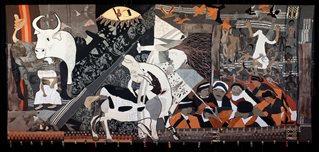Community tapestry-making facilitates dialogue and channels political thinking through the Guernica iconography of Picasso
Nicola Ashmore’s research uses collaborative activist art practice through the act of making to demystify artistic practices and processes, and to foster solidarity and socio-political engagement. Using film, exhibition and public engagement activities, she has investigated how the historically and culturally specific moment of war and conflict at Guernica is translated to a different experience through the collective community-based remaking of Picasso’s Guernica in UK, South Africa, Mauritius, Syria, Canada, America, Iraq and Afghanistan.
A Guernica banner remaking project was initiated from the University of Brighton by Dr Louise Purbrick in 2012. She involved 12 artists and activists from Brighton, Nicola Ashmore among them, and held 14 public collaborative sewings in England and India. The subsequent Guernica Remakings have combined research and practice to build a global collective of remakers. This has significantly expanded the geographical reach and scale of its impact across diverse communities and organisations. Nicola Ashmore has initiated further cultural iterations across three countries (UK, South Africa, Mauritius,) involving nine individual artists and four artist collectives.
Each installation of the Guernica Remakings Exhibition responds to its location by incorporating contextual materials and inviting local artist and public responses to the work. The remaking process with the Keiskamma Art Project in South Africa has enabled the sharing of lived experiences, particularly in relation to the HIV/AIDS crisis.
Collaborating in Mauritius with charity Future Hope and Savina Tarsitano of Kids Guernica, Nicola Ashmore enabled 50 children from disadvantaged families in Port Louis to explore their visions of the future and promote a message of peace over conflict, through the production of their own Kids Guernica (2019). The collaborative art making process and its later display in Japan helped facilitate dialogue between different cultures.
Nicola Ashmore's research on remakings of the 'Guernica' image for social and political empowerment can be found on a pdf document, Guernica Remakings, detailing the work.

Nicola Ashmore works with communities in South Africa, India and Mauritius as well as the United Kingdom to understand how the iconic Guernica painting is used to empower communities through collaborative remakings. [Image above and top, Keiskamma Guernica 2015. Courtesy Nicola Ashmore.]